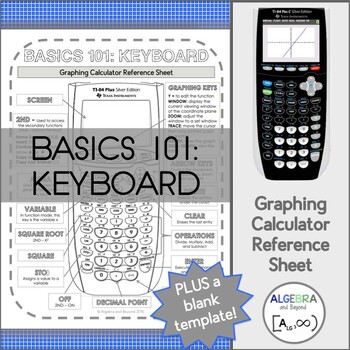TI-84 Keyboard Basics | Graphing Calculator Reference and Practice Sheet
- PDF
What educators are saying
Also included in
- Build your students’ understanding of the TI-84 graphing calculator without repeating yourself over and over again - these graphing calculator reference sheets are step-by-step guides on how to use the TI-84 calculator for 40 different math topics in Algebra 1, Algebra 2, and Precalculus! Add thesePrice $45.00Original Price $75.00Save $30.00
Description
This TI-84 Plus CE graphing calculator reference sheet identifies frequently used keys on the keyboard and their purpose. This resource is helpful for students that are just starting to use the graphing calculator. PLUS, a blank template for both TI-84 Plus and TI-84 Plus CE are included, so you can use it for other keystrokes you want students to be familiar with.
INCLUDED:
- Reference Sheet: A reference page to identify frequently used keys.
- Blank Template: Identify other keystrokes and functions of the keyboard.
- Practice Sheet: A practice page with 7 problems for students to review what they've learned. Includes answer key.
Purpose of Reference Sheets:
- Reliability: Step-by-step guides build strong habits when solving.
- Confidence: After instruction, students are able to work independently.
- Accommodations & Scaffolding: Reference sheets are a key resource listed in many students’ IEPs.
Why Focus on Graphic Calculator Skills?
- Increase Speed: Compute, graph, create a table of values quickly & efficiently.
- Build Connections: Make connections between different mathematical models - quickly maneuver among tabular, graphical, and algebraic forms.
- Check for Accuracy: Check that work - confirm or disaffirm solutions.
- Leap Over Hurdles: Use technology to close gaps - even students with little understanding of fractions and algebra can access rich mathematics.
Build Your Student’s Calculator Skills With Ease:
- Find more graphic calculator reference sheets here.
- Grab them all in one place with my Graphing Calculator Reference Sheets Bundle!
∞∞∞∞∞∞∞∞∞∞∞∞∞∞∞∞∞∞∞∞∞∞∞∞∞∞∞∞∞∞∞∞∞∞∞∞∞∞∞∞∞∞∞∞∞∞∞
Learn more about Algebra and Beyond's resources:
• Website
© Algebra and Beyond
This product is intended for personal use in one classroom only. For use in multiple classrooms, please purchase additional licenses.






